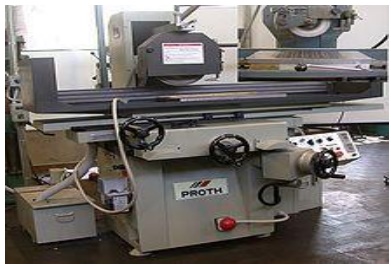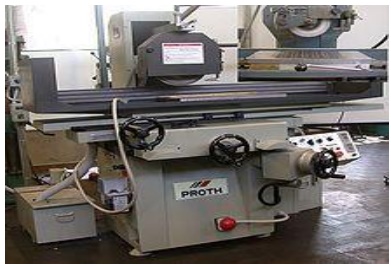Chapter: Mechanical : Manufacturing Technology : Abrasive Process and Broaching
Outside Diameter Grinding

Outside Diameter Grinding
OD grinding is
grinding occurring on external surface of an object between the centers. The
centers are end units with a p oint that allow the object to be rotated. The
grinding wheel is also being rotated in the sa me direction when it comes in
contact with the object. This effectively means the two surfaces will be moving
opposite directions when contact is made which allows for a smoother o peration
and less chance of a jam up.
Plunge grinding
A form of OD grinding, ho wever the major difference is that the
grinding wheel makes continuous contact with a sing le point of the object
instead of traversing the object.
Creep feed grinding
Creep Feed is a form of grinding where a full depth of cut is removed in a single pass of the wheel. Successful operation of this technique can reduce manufacturing time by 50%, but often the grinding machine being used must be designed specifically for this purpose. This form occurs in both cylindrical and Surface Grinding.
Surface Grinding

Surface grinding is used to
produce a smooth finish on flat surfaces. It is a widely used abrasive
machining process in which a spinning wheel covered in rough particles
(grinding wheel) cuts chips of metallic or nonmetallic substance from a
workpiece, making a face of it flat or smooth.
Surface grinding is the most
common of the grinding operations. It is a finishing process that uses a
rotating abrasive wheel to smooth the flat surface of metallic or nonmetallic
materials to give them a more refined look or to attain a desired surface for a
functional purpose.
The surface grinder is composed
of an abrasive wheel, a workholding device known as a chuck, and a
reciprocating or rotary table. The chuck holds the material in place while it
is being worked on. It can do this one of two ways: ferromagnetic pieces are held
in place by a magnetic chuck, while non-ferromagnetic and nonmetallic pieces
are held in place by vacuum or mechanical means. A machine vise (made from
ferromagnetic steel or cast iron) placed on the magnetic chuck can be used to
hold non-ferromagnetic workpieces if only a magnetic chuck is available.
Factors to consider in surface
grinding are the material of the grinding wheel and the material of the piece
being worked on.
Typical workpiece materials
include cast iron and mild steel. These two materials don't tend to clog the
grinding wheel while being processed. Other materials are aluminum, stainless
steel, brass and some plastics. When grinding at high temperatures, the
material tends to become weakened and is more inclined to corrode. This can also
result in a loss of magnetism in materials where this is applicable.
The grinding wheel is not limited to a cylindrical shape and can
have a myriad of options that are useful in transferring different geometries
to the object being worked on. Straight wheels can be dressed by the operator
to produce custom geometries. When surface grinding an object, one must keep in
mind that the shape of the wheel will be transferred to the material of the
object like a mirror image.
Spark out is a term used when precision values are sought and literally
means "until the sparks are out (no more)". It involves
passing the workpiece under the wheel, without resetting the depth of cut, more
than once and generally multiple times. This ensures that any inconsistencies
in the machine or workpiece are eliminated.
A surface grinder
is a machine
tool used to provide precision ground
surfaces, either to a critical size or for the
surface finish.
The typical
precision of a surface grinder depends on the type and usage, however +/-0.002
mm (+/- 0.0001") should be achievable on most surface grinders.
The machine
consists of a table that traverses both longitudinally and across the face of
the wheel. The longitudinal feed is usually powered by hydraulics, as may the cross feed, however any mixture of hand,
electrical or hydraulic may be used depending on the ultimate usage of the
machine (i.e.: production, workshop, cost). The grinding wheel rotates in the
spindle head and is also adjustable for height, by any of the methods described
previously. Modern surface grinders are semi-automated, depth of cut and
spark-out may be preset as to the number of passes and, once set up, the
machining process requires very little operator intervention.
Depending on the
workpiece material, the work is generally held by the use of a magnetic chuck.
This may be either an electromagnetic chuck, or a manually operated, permanent
magnet type chuck; both types are shown in the first image.
The machine has
provision for the application of coolant
as well as the extraction of metal dust (metal and grinding particles).
Types of surface grinders
Horizontal-spindle
(peripheral) surface grinders. The periphery (flat edge) of the wheel is
in contact with the workpiece, producing the flat surface. Peripheral grinding
is used in high-precision work on simple flat surfaces; tapers or angled
surfaces; slots; flat surfaces next to shoulders; recessed surfaces; and
profiles.
Vertical-spindle
(wheel-face) grinders. The face of a wheel (cup, cylinder, disc, or
segmental wheel) is used on the flat surface. Wheel-face grinding is often used
for fast material removal, but some machines can accomplish high-precision
work. The workpiece is held on a reciprocating table, which can be varied
according to the task, or a rotary-table machine, with continuous or indexed
rotation. Indexing allows loading or unloading one station while grinding
operations are being performed on another.
Disc grinders and double-disc grinders. Disc grinding is similar
to surface grinding, but with a larger contact area between disc and workpiece.
Disc grinders are available in both vertical and horizontal spindle types.
Double disc grinders work both sides of a workpiece simultaneously. Disc
grinders are capable of achieving especially fine tolerances.
Related Topics